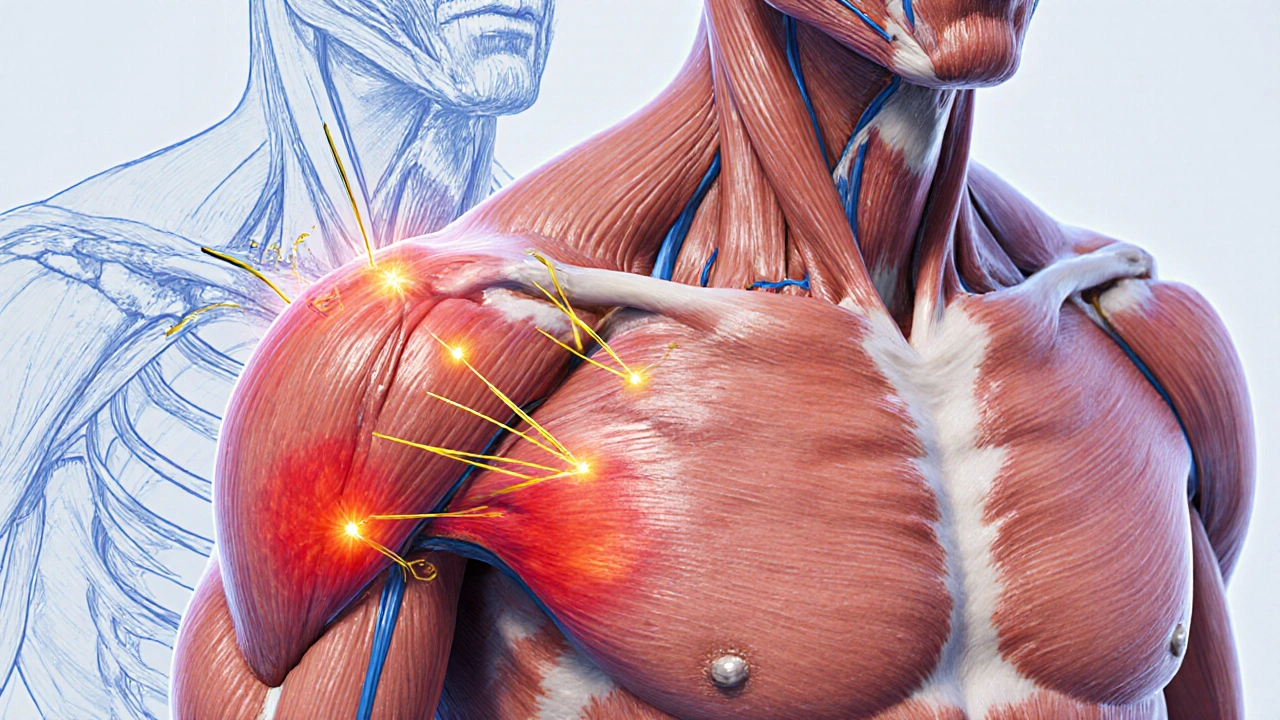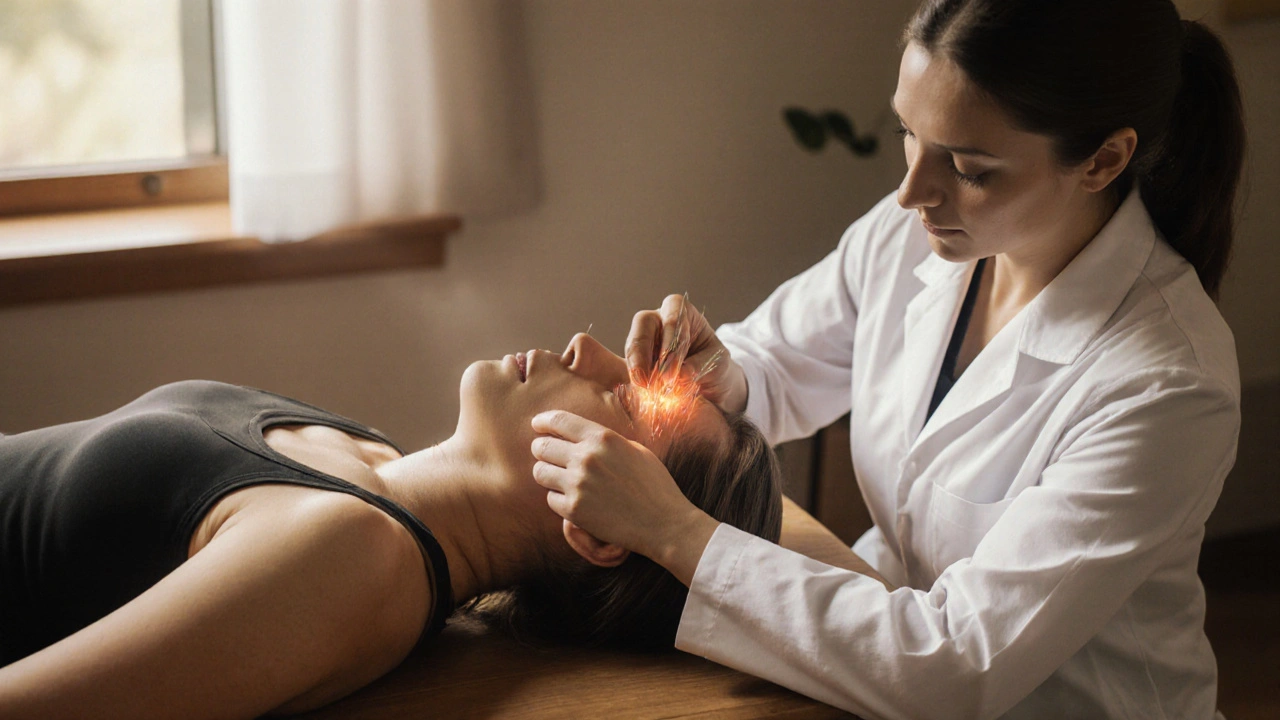Acupuncture Cost Comparison Calculator
Estimate Your Treatment Costs
Compare acupuncture costs with other common muscle ache treatments based on research data from the article.
Results
Based on research in the article, here's how your treatment options compare.
How This Calculator Works
Acupuncture costs $70-$120 per session, while physiotherapy costs $80-$150 per session and NSAIDs cost $0-$30 per dose. The calculator uses data from clinical studies showing:
- Acute muscle aches often improve after 1-3 sessions
- Chronic muscle issues typically require 6-12 sessions
- Acupuncture can reduce pain scores by 2.1 points on a 10-point scale
Quick Takeaways
- Acupuncture can ease muscle aches by releasing endorphins and reducing inflammation.
- Clinical trials show measurable pain reduction for both acute and chronic muscle soreness.
- Sessions are safe when performed by certified practitioners and often complement physiotherapy or NSAIDs.
- Typical treatment involves 15-30 minute needle placements, with noticeable relief after 1-3 visits.
- Choosing a licensed therapist familiar with Traditional Chinese Medicine (a holistic system that includes acupuncture, herbal formulas, and bodywork) improves outcomes.
What Is Acupuncture (a needle‑based therapy rooted in Traditional Chinese Medicine that aims to balance the body’s energy pathways, or meridians)?
During an Acupuncture session, thin sterile needles are inserted at specific points on the skin. The goal isn’t to poke you for the sake of it; it’s to stimulate nerves, muscles, and connective tissue, prompting a cascade of biochemical responses that can calm pain signals.
Why Muscle Aches Respond to Acupuncture
Muscle aches-whether from over‑training, poor posture, or a lingering strain-often involve three key physiological culprits: Inflammation, Endorphins, and Myofascial Pain (tight knots in the fascia that restrict movement). When needles hit the right points, they trigger the brain to release Endorphins, the body’s natural painkillers, while simultaneously dampening the inflammatory response. This double‑action can translate into a softer, more relaxed muscle and a lower pain rating.

Research Snapshot: How Effective Is Acupuncture for Muscle Pain?
Several peer‑reviewed studies provide a data‑driven view:
- A 2022 meta‑analysis of 23 randomized controlled trials (RCTs) involving over 1,800 participants found that acupuncture reduced average muscle‑pain scores by 2.1 points on a 10‑point scale-significantly better than sham needling.
- In a US Army study of soldiers with delayed‑onset muscle soreness, 8 sessions of acupuncture cut recovery time by 30% compared to a control group using only rest and NSAIDs.
- Long‑term follow‑up of chronic lower‑back muscle pain patients showed a 45% sustained reduction in medication usage after just six weekly acupuncture visits.
These numbers suggest that acupuncture isn’t just a placebo; it delivers quantifiable pain relief that can complement-or sometimes replace-standard drug therapies.
How Acupuncture Stacks Up Against Common Treatments
| Criterion | Acupuncture | NSAIDs | Physiotherapy |
|---|---|---|---|
| Primary Mechanism | Stimulates nerve pathways, releases endorphins, reduces inflammation | Inhibits cyclooxygenase enzymes, lowers prostaglandin‑mediated inflammation | Improves muscle strength, flexibility, and circulation through guided exercises |
| Onset of Relief | 30minutes-2hours (often after 1-3 sessions) | 1-2hours after dose | Several weeks of consistent sessions |
| Side‑Effect Profile | Minor bruising, temporary soreness at needle sites | Gastrointestinal upset, cardiovascular risk with long‑term use | Rare, may cause temporary muscle soreness |
| Cost per Session (USD) | $70‑$120 | $0‑$30 (over‑the‑counter) or prescription cost | $80‑$150 |
| Evidence Strength | Moderate‑to‑high (multiple RCTs) | High for short‑term relief, low for chronic muscle pain | High for functional improvement, moderate for pain relief |
As the table shows, acupuncture offers a blend of rapid relief and low systemic risk, making it a solid alternative when NSAIDs aren’t advisable or when physiotherapy alone doesn’t fully alleviate soreness.
What to Expect in an Acupuncture Session
- Consultation: The practitioner asks about your medical history, pain location, and lifestyle. This helps them choose the right meridian points.
- Needle Placement: Thin, sterile needles (usually 0.25mm diameter) are inserted 2-10mm deep, depending on the target area.
- Needle Manipulation: Gentle twirling or slight electrical stimulation may be applied for 15-30minutes to enhance the therapeutic effect.
- Relaxation: You’ll lie comfortably; many clients report a warm, tingling sensation that spreads through the muscle.
- After‑care: The practitioner removes the needles, offers stretching tips, and suggests hydration to aid toxin elimination.
Most people feel a subtle improvement within the first hour. If you’re new, you might experience minor soreness at the needle sites-this usually fades quickly.

Choosing a Qualified Practitioner
Safety hinges on proper training. Look for these credentials:
- Certification from a recognized acupuncture board (e.g., NCCAOM in the US or the New Zealand Acupuncture Association).
- Formal education in Traditional Chinese Medicine, including anatomy and physiology coursework.
- Clear hygiene protocols: single‑use, disposable needles and a clean treatment space.
- Positive patient reviews that mention relief from Muscle Aches or related conditions.
Don’t hesitate to ask the practitioner about their experience with sports‑related injuries, trigger‑point therapy, or chronic myofascial pain-these specialties often translate to better outcomes for muscle soreness.
Integrating Acupuncture With Other Therapies
Acupuncture doesn’t have to stand alone. Many athletes and rehab patients combine it with:
- Physiotherapy to restore strength and range of motion after the pain subsides.
- Gentle stretching or yoga, which keeps the muscle fibers elongated and reduces the chance of re‑triggering knots.
- Topical NSAIDs for breakthrough pain, but only under a doctor’s guidance to avoid overuse.
This multimodal approach often yields faster recovery and longer‑lasting pain relief than any single method.
Common Concerns Addressed
- Is acupuncture painful? The needles are extremely fine-most people describe the sensation as a light tap or a mild tingling.
- Can I have acupuncture if I’m on blood thinners? Generally yes, but the practitioner should use shallower insertion points and avoid areas with high vascularity.
- How many sessions will I need? Acute aches often improve after 1-3 visits; chronic issues may require 6-12 sessions spaced weekly.
- Will insurance cover it? In many regions, health plans now include acupuncture for pain management, especially when prescribed by a physician.
Frequently Asked Questions
How soon can I feel relief after an acupuncture session?
Most clients notice a reduction in muscle tightness within 30minutes to a few hours. Full pain relief may take a few sessions, especially for chronic aches.
Is acupuncture safe for pregnant women with muscle soreness?
When performed by a certified practitioner trained in prenatal care, acupuncture is considered safe. Certain points are avoided during pregnancy, but many relief techniques are still available.
Can I combine acupuncture with massage therapy?
Yes. In fact, many clinics offer integrated sessions where acupuncture is followed by a gentle massage to further release tension and improve circulation.
What are the signs that acupuncture isn’t working for me?
If after six consecutive weekly visits you see no change in pain intensity or functional ability, discuss alternative points or complementary therapies with your practitioner.
Do I need to shave the area before needle insertion?
No. Modern disposable needles are thin enough to glide through hair. The practitioner will clean the skin with alcohol wipes to ensure sterility.

kristina b
Acupuncture, as described in the article, emerges not merely as a therapeutic modality but as a profound dialogue between needle and nervous system; each insertion invokes a cascade of biochemical events that reverberate through the musculoskeletal architecture.
First, the micro‑injury stimulates A‑delta fibers, provoking the release of endogenous opioids such as endorphins, which then bind to receptors that blunt nociceptive transmission.
Second, the localized mechanical stimulus modulates inflammatory mediators, attenuating prostaglandin synthesis and thereby reducing swelling that perpetuates muscular tension.
Third, the rhythmic sensation of needles can recalibrate the autonomic balance, shifting the sympathetic dominance often observed in chronic ache toward parasympathetic serenity.
Clinical data cited in the piece reveal an average reduction of 2.1 points on a ten‑point pain scale, a statistically significant figure across dozens of randomized trials.
Moreover, the temporal dynamics are noteworthy: acute sufferers frequently discern relief within thirty minutes to a few hours after a single session, while chronic patients may require six to twelve weekly visits to achieve durable amelioration.
The cost analysis underscores a nuanced economic picture, positioning acupuncture between the low‑cost NSAID regimen and the higher, yet functionally complementary, physiotherapy package.
Insurance coverage, when present, further narrows the financial gap, rendering the modality accessible to a broader demographic.
Importantly, safety is predicated upon practitioner expertise; certified acupuncturists adhere to stringent aseptic protocols, employing disposable, single‑use filaments that eliminate transmissible risk.
For individuals on anticoagulants, adjustments in needle depth and site selection mitigate hemorrhagic concerns, preserving therapeutic benefit without compromising hemostasis.
The article also advocates a multimodal approach, suggesting that post‑acu therapeutic stretching or yoga can consolidate gains achieved during needle placement.
From a biomechanical standpoint, the integration of acupuncture with targeted physiotherapy may accelerate collagen remodeling and muscle fiber realignment, hastening functional restoration.
Ethically, the emphasis on informed consent and patient education aligns with contemporary standards of shared decision‑making in pain management.
In sum, the evidence presented invites a reassessment of acupuncture not as a fringe curiosity but as a viable, evidence‑backed adjunct in the armamentarium against muscular discomfort.
Ida Sakina
One must consider the moral imperative of seeking treatments that do not harm the body or the environment and acupuncture, when performed responsibly, fulfills this ethical duty
Amreesh Tyagi
Acupuncture is just a placebo they say but the data in the article contradicts that claim
Brianna Valido
Totally love how acupuncture can be a quick fix for sore muscles 😄 It’s great to have another option besides popping pills 🌿